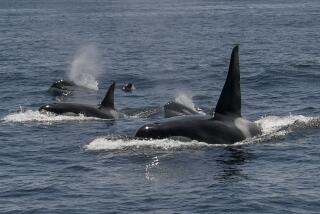The biggest animals in the ocean are more likely to go extinct

A new study finds large marine animals are significantly more likely to go extinct than smaller ones.
- Share via
What happens when you remove all the biggest animals from the ocean? If you could stick around for the next few thousand years, you might find out.
A new study finds that in our modern era, large marine animals are significantly more likely to go extinct than small ones.
It’s a disturbing pattern that has the potential to wipe out many of the top predators in our oceans, and researchers say it’s unprecedented in the history of our planet.
“The Earth is experiencing something it has never experienced before,” said study leader Jonathan Payne, a paleobiologist at Stanford University. “Biologically, we are going into uncharted territory.”
He and his colleagues add that losing our biggest marine animals could have unexpected effects on the ocean ecology.
“We might be skimming off the top of the food web, or changing the distribution of temperature and energy,” said Noel Heim, a postdoctoral researcher in Payne’s lab and a coauthor on the study. “A blue whale diving down to feed might mix a whole lot of ocean water. A larger clam will mix more sediments than a smaller one.”
In the paper published this week in the journal Science, the authors examined the traits of 2,497 marine vertebrates and mollusks, including some that have already gone extinct and those in danger of joining them in the near future. The list of modern at-risk animals was taken from the International Union for Conservation of Nature’s Red List of Threatened Species.
The researchers considered four traits in particular: size (the animal’s length), habitat zone (whether it lived in open water or on the seafloor), motility (if it swims around or stays in one spot) and feeding (whether it is a predator or not).
Next they considered how these traits were correlated with extinction rates during five mass extinction events over the last 455 million years, as well as what they call the background extinction rates of the last 66 million years.
“Background extinction is in contrast to these five intervals of mass extinction,” Heim said. “Things are always going extinct and are always being replaced with new species. We consider this the normal rate of extinction.”
The authors found that during the mass extinction events, smaller animals were a tad more likely than larger animals to go extinct. In addition, animals that could swim were more likely to be wiped out during all but the last mass extinction event compared with those that were stationary, and marine animals that lived in the open water were more likely to die off than those who made their homes on the ocean floor.
Over the last 66 million years, however, different patterns have emerged.
During most of this period, predators have been slightly more likely to go extinct than non-predators and mobile animals were more likely to die off than those that could not swim around. Up until recently, small animals were a little more likely to face extinction than larger ones.
However, in the last 500 years, the pattern has shifted dramatically. Now size has overtaken all other factors as the biggest predictor of likely extinction — and by a lot.
The authors report that for modern marine vertebrates and mollusks, the risk of extinction rises by a factor of 13 for every tenfold increase in the animal’s size. That means that compared with a small marine animal, one that’s 10 times bigger is 13 times more likely to become extinct.
“I was surprised by how strong and consistent the body size signal was,” Payne said. “It shows up every way we treat the data.”
That presents a problem for animals of all sizes, said Stuart Pimm, a professor of conservation ecology at Duke University who was not involved in the research.
“Big animals are important in themselves, but removing them could also dramatically change marine ecology and the way oceans work,” he said.
Although the study does not directly address the reason large animals have become more vulnerable, the authors are pretty sure they know what’s behind it: us.
“After looking at the fossil record and then looking at fisheries studies, we can’t think of anything but human hunting that might be the cause of this very strange size selectivity,” Heim said.
The authors also noted that the pressures on large-bodied marine animals are similar to those experienced by large-bodied terrestrial animals that were hunted to extinction earlier in human history, like mammoths.
“It’s easier to pick off the biggest animals whether it’s on land or at sea,” Heim said. “It takes less energy to catch a big whale or a single elephant or mastodon than catching an equal mass of smaller fish or the equivalent number of deer.”
Nicholas Pyenson, curator of fossil marine mammals at the Smithsonian’s National Museum of Natural History in Washington, said the new study is exciting because scientists have generally had a difficult time comparing mass extinctions in the fossil record to what is transpiring today.
“What this team has done is come up with a clever and clean way to compare the intensity of extinction in the deep, geologic past with those we can document now, specifically for the oceans,” said Pyenson, who was not involved in the work. “We are clearly targeting the biggest species in the oceans, which is a major concern given their relative outsized ecological importance.”
The good news is that there’s still time to reverse this trend. Payne and Heim pointed to the history of the elephant seal, which was hunted almost to extinction in the early 1900s but has since rebounded after it was protected by law.
“There were somewhere around 100 left at the turn of the 20th century, but now there are 200,000 individuals,” Heim said. “We have the capacity to degrade the system, but there are hopeful examples that suggest if we change what we are doing, we can have a positive impact.”
Pimm agreed.
“A paper like this is a warning of what will happen if we don’t get our act together,” he said. “We have brought gray whales back from the brink of extinction, and blue whales are coming back too. If you let these species alone, they can come back and recover.”
Do you love science? I do! Follow me @DeborahNetburn and “like” Los Angeles Times Science & Health on Facebook.
MORE IN SCIENCE
As popularity of e-cigarettes rises, more smokers are able to quit, study says
Is youth soccer getting more dangerous? The injury rate has more than doubled since 1990.
Pneumonia: What does Clinton’s affliction say about her health?
UPDATES:
Sept. 15, 6:05 p.m.: This article has been updated with comments from Nicholas Pyenson, curator of fossil marine mammals at the Smithsonian’s National Museum of Natural History in Washington.
This article was originally published on Sept. 14 at 11:05 a.m.







